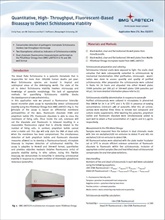Members Login

Channels
Special Offers & Promotions
New Application Note from BMG LABTECH - "Quantitative, High- Throughput, Fluorescent-Based Bioassay to Detect Schistosoma Viability"
 The blood fluke Schistosoma is a parasitic trematode that is
responsible for more than 200,000 human deaths per year. Most Schistosoma species are located in
tropical and subtropical areas of the delveloping world. The state of the art
to detect Schistosoma viability involves microscopy and knowledge of parasite
morphology. The lack of appropriate methods for quantifying Schistosoma
viability blocks the development of new anthelmintics.
The blood fluke Schistosoma is a parasitic trematode that is
responsible for more than 200,000 human deaths per year. Most Schistosoma species are located in
tropical and subtropical areas of the delveloping world. The state of the art
to detect Schistosoma viability involves microscopy and knowledge of parasite
morphology. The lack of appropriate methods for quantifying Schistosoma
viability blocks the development of new anthelmintics.In this application note we present a fluorescence intensitybased microtiter plate assay to reproducibly detect schistosomal viability using the POLARstar Omega from BMG LABTECH (Fig.1). The principle of the assay is based on differential membrane permeabilities of the dyes, fl uorescein diacetate (FDA) and propidium iodide (PI). Fluorescein diacetate is able to cross the membrane of living cells. Once inside the cell, esterases will cut the diacetate and fluorescein is released resulting in a measurable fluorescence signal that is directly related to the number of living cells. In contrast, propidium iodide cannot enter a viable cell. This dye will only stain the DNA of dead cells when the membrane has been compromised. The simultaneous detection of both propidium iodide and fluorescein diacetate measures allowed us to develop a fluorescence-based, microplate bioassay to improve detection of schistosomal viability. The assay is adaptive to 96-well and 384-well format, quantitative and provides objective readouts (relative fluorescence units) of parasite viability during in vitro culture. Using this flexible bioassay, we demonstrate its versatility in detecting schistosomal viability in response to a known inhibitor of thioredoxin glutathione reductase (auranofin).
To view the full article please click here
Media Partners


